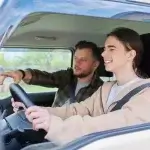Home / Compare Car Insurance / A guide to L-plates and…
A guide to L-plates and car insurance for learner drivers



Key takeaways
- ‘Learner driver insurance’ isn’t a specific policy.
- Standard car insurance products can insure L-platers.
- While the rules for learner drivers are similar across Australia, restrictions may differ between states and territories.
The basics
What is a learner licence in Australia?
 A learner licence (also known as ‘L plates’) is a permit that allows people to drive with the supervision of a licensed driver. You can typically get this type of licence from the age of 16. After holding a learner licence for 12 months and driving with supervision for a set amount of hours, you can apply for a provisional licence (or ‘P plates’).
A learner licence (also known as ‘L plates’) is a permit that allows people to drive with the supervision of a licensed driver. You can typically get this type of licence from the age of 16. After holding a learner licence for 12 months and driving with supervision for a set amount of hours, you can apply for a provisional licence (or ‘P plates’).
How many hours do I need to drive on my learners?
Here’s a breakdown of the supervised driving hours required by each state/territory for learner drivers under 25:
- QLD: 100 hours (10 hours at night)1
- NSW: 120 hours (20 hours at night)2
- Victoria: 120 hours (20 hours at night)3
- SA: 75 hours (15 hours at night)4
- WA: 50 hours (5 hours at night)5
- Tasmania: 80 hours (15 at night)6
- ACT: 100 hours (10 at night)7
- NT: None.8
Learner licence conditions in Australia
While certain learner driver licence conditions may vary by state, there are rules L-platers generally need to follow when driving in Australia:
- L plates must be on the front and back of your car
- Your blood alcohol must be at zeroYou must have your licence with you
- Someone with a full Australian driver’s licence for your class of vehicle should be supervising you.
Learner driver restrictions in QLD
Queensland L-platers must have a supervising driver who has held their licence for the same vehicle class the learner drives for one year or longer.9
Phones can’t be used or handled by the learner driver – even if it’s switched off or on a hands-free kit. However, when safely parked, the learner driver may use their phone to:
- Pay for something with Apple Pay or a similar app (e.g. in a takeaway drive-through)
- Enter a car park or other paid road area
- Access a digital driver’s licence when requested by the police
- Access a phone wallet.9
Supervisors and passengers are also not allowed to use the speaker function on their phones if the learner driver is under 25.
Learner driver restrictions in NSW
Learner drivers in NSW can’t drive faster than 90km/h and can’t use their phones while driving.10
L-platers in Sydney also can’t drive in the following parks:
- Parramatta Park
- Moore Park
- Centennial Park.10
Learner driver restrictions in Victoria
Victorian L-platers can’t use any portable devices while driving unless it’s attached to a secure mounting.11 Mounted devices may only be used for audio (e.g. music and podcasts) or navigation and must be set up before driving.
Learner drivers in Victoria also can’t tow other vehicles, trailers and caravans.11
Learner driver restrictions in SA
Learner drivers in South Australia can’t drive any faster than 100km/h and generally can’t ride motorbikes between midnight and 5 am if they’re under 25.12 They also can’t operate mobile phones while driving, unless the car has stopped and it’s for the following purposes:
- To pay for something with an Apple Wallet, Samsung Wallet or a similar app
- To show digital identification when requested
- To enter a car park or other road areas.12
Learner driver restrictions in WA
Western Australian L-platers are not allowed to exceed 100km/h and can’t drive within Kings Park or other areas prohibiting learner drivers.5
Learner driver restrictions in Tasmania
Tasmanian learner drivers have a speed limit of 90km/h and can’t tow other vehicles or trailers. They also can’t operate a mobile phone while driving.13
Learner driver restrictions in the ACT
Learner drivers in the ACT can’t tow trailers heavier than 750kg.14 There is also a full ban on using mobiles while driving unless the device is securely mounted and used for GPS purposes. Learner drivers should set up any GPS navigation before driving.
Learner driver restrictions in the NT
Territorians on their L-plates have a speed limit of 80km/h and can’t use mobile phones while driving.15
Supervising a learner driver and passenger limits
Who can supervise a learner driver in Australia?
The supervising passenger needs to hold an open licence for the vehicle the L-plater is driving. This means drivers on a provisional licence (or ‘P-platers’) can’t supervise learner drivers.
How many passengers can a learner driver have?
Aside from the licensed supervisor in the passenger seat, learner drivers can typically only have one other person under 21 in the car unless they’re family members (e.g. siblings). This rule may differ depending on the state or territory you’re in.
Car insurance for learner drivers
Does a learner driver need to be insured?
Vehicles driven by L-platers must have Compulsory Third Party (CTP) Insurance. CTP typically covers your legal liability for injuries and death in car accidents where you’re at fault.
What is the best car insurance for learner drivers?

The best type of car insurance for you will depend on what you’re looking to cover.
To cover damages to other vehicles and property, you’ll require a form of third party car insurance, whether it’s Third Party Property Damage cover or a Third Party Fire and Theft policy. Comprehensive car insurance policies also offer these benefits, plus coverage for your own car.
Whichever type of car insurance cover you’re looking to purchase, always read the relevant Product Disclosure Statement (PDS) for full details on inclusions, exclusions, limits and terms and conditions. The Target Market Determination (TMD) may also help you figure out if the product is right for your circumstances.
Are learner drivers covered by the supervisor’s insurance?
It depends on your insurance company. Some insurers may cover learner drivers through their supervising driver’s car insurance policy. However, there may be excesses on top of the standard excess if you need to make a car insurance claim:
- Age excess. If the L-plate driver is under 25 years of age, the policy might charge an additional excess if they need to make a claim.
- Inexperienced driver excess. This excess comes into effect when the driver making a claim hasn’t had their open licence for a certain period of time.
For more information about what excesses may apply to certain claims, read the PDS for your car insurance policy.
Can you add a learner driver to your car insurance?
Like other drivers, L-platers may be added to an existing policy. If you’re looking to add a learner driver to your cover, contact your insurance company and update your policy to include them.
Keep in mind your insurer might adjust your premiums to account for the additional risk that comes with an inexperienced motorist driving your car. For example, if you previously agreed that no one under a certain age will drive your vehicle, you will no longer be eligible for that potential discount and your premiums may increase.
How can I get cheap car insurance for learner drivers?
Due to their inexperience behind the wheel, young drivers typically pay more for cover than their more experienced counterparts. However, there are still some ways you could save on your car insurance premiums, including:
- Parking in a garage. Parking your car somewhere secure means it’s less likely to get damaged. Your insurance company could view this favourably when calculating your premiums.
- Paying premiums annually. Annual premiums are subject to less processing fees than monthly instalments.
- Paying a higher excess. Increasing the excess you pay could lower your overall premium. Before adjusting your excess, it’s worth considering whether you can pay a higher amount if you need to claim.
If you’re learning to drive your parents’ car, you could save money by being included on their policy. However, if it’s your own car, consider getting a separate policy under your name. Listing your parents as the primary driver of your own car could land you in trouble with your insurer and even void your policy.
Meet our car insurance expert, Adrian Taylor
As a General Insurance expert with over 13 years’ experience in financial services, Adrian Taylor is passionate about demystifying car insurance for consumers, so they have a better understanding of what they’re covered for. Adrian’s goal is to make more information available from more insurers, to make it easier to compare and save.
1Queensland Government – Queensland licensing. Accessed 12 July 2024.
2NSW Government – Using your Learner Driver Log Book. Accessed 12 July 2024.
3Vic Roads – 120 hours driving experience. Accessed 12 July 2024.
4Government of South Australia – Learner’s permit. Accessed 12 July 2024.
5Government of Western Australia – Learner drivers. Accessed 12 July 2024.
6Tasmanian Government Transport Services – FAQs. Accessed 12 July 2024.
7ACT Government – Get your provisional driver licence. Accessed 12 July 2024.
8Northern Territory Government – Motor Vehicle Registry road users’ handbook. Accessed 12 July 2024.
9Queensland Government – Rules for learner driving. Accessed 12 July 2024.
10NSW Government – Learner driver licence. Accessed 12 July 2024.
11Vic roads – Restrictions on learner drivers. Accessed 12 July 2024.
12Government of South Australia – My car licence: Learner’s stage. Accessed 12 July 2024.
13Plates Plus Tasmania – Summary of novice car licensing pathway. Accessed 12 July 2024.
14ACT Government – Get your learner driver licence. Accessed 12 July 2024.
15Northern Territory Government – Learner Drivers’ Guide. Accessed 11 July 2024.

